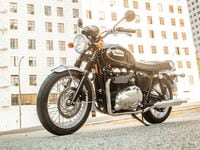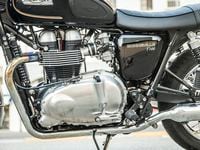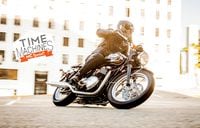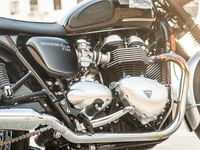Call it luck or good business, but Triumph has played this surge in retro popularity perfectly, as the Bonneville has become the go-to choice for thousands of riders since its revival in 2001. In fact, it's not beyond the scope of reason to credit Triumph with a key role in the boom of classic style, and the reason for that is twofold. First, the reintroduction of the modern Bonnie predates its contemporaries (many of them featured on the surrounding pages), and, second, the execution and value has been nearly impossible to match.
While Triumph produces many Bonneville brethren (Thruxton, Scrambler, Speedmaster, and America) the original is the epitome of classic style in a modern package. A swoopy, 1960s-style gas tank meets a classic bench seat; a simple instrument panel adds to the look, as do twin shocks and bullet blinkers. The T100 swaps spoke wheels (19-inch on the front) for the base bike’s 17-inch cast-aluminum hoops and adds two-tone paint, fork gaiters, peashooter pipes, and a smattering of polished engine covers.
As vintage as the Bonneville looks (every time we have a Bonnie around we get stopped and asked how old it is) up-to-date technologies are everywhere, some more obvious than others. Sturdy, two-pot calipers squeeze single-disc brakes with the help of braided-steel lines, and, no, those aren’t carburetors but actually convincing impersonators that double as throttle bodies for electronic fuel injection.
Indeed, the engine’s air-cooling disguises the refinement that hides inside. What launched nearly 15 years ago as a carbureted, 790cc interpretation of the classic parallel twin evolved into an 865cc, fuel-injected version by 2009 and remains largely unchanged today. It’s a gem. Throttle response is nearly perfect, delivering 59 hp as delicately or briskly as you like.
It’s a tremendously easy bike to operate and feels lighter than the scale indicates (more than 500 pounds, incidentally). A 30.5-inch seat height means it’s approachable, and a tight, precise chassis combined with solid KYB suspension makes the Bonnie light to the touch and pleasant to steer, whether bombing along deserted roads or fighting through traffic. (It’s interesting to note that the modern Bonnie is seen as a good starter bike, when the original 650cc Bonneville was celebrated as an ultimate performance machine in its heyday.)
Aside from the aforementioned Bonnie spinoffs, different versions of the Bonneville itself make choosing what you want more difficult. It’s never terribly expensive though. The base bike starts at $7,899, while the up-spec T100 will cost you no less than $9,199. This T100 Special Edition pictured—it includes brushed engine covers, black shocks and mirrors, and a paint scheme commemorating the last Bonneville that rolled out of the Meriden, England, factory in 1982—is the most bourgeoisie of Bonnevilles and still comes in under $10,000.
You might be thinking that $9,799 is too much to pay for a cute slice of history. True, in a modern context it lacks some amenities; there’s no ABS, and the dash is hardly more than two analog dials, but the reason we like the Bonneville is because it’s more than that. It’s a functional, sweet-hearted machine that has been faithfully redrawn and superbly finished to create a truly capable and enjoyable motorcycle.

















/cloudfront-us-east-1.images.arcpublishing.com/octane/7GJYDUIPXRGMTMQKN6ONYOLBOU.jpg)
/cloudfront-us-east-1.images.arcpublishing.com/octane/MUQLOVLL2ZDGFH25ILABNBXKTI.jpg)
/cloudfront-us-east-1.images.arcpublishing.com/octane/TNOU5DNE2BC57MFPMGN2EIDXAM.jpg)
/cloudfront-us-east-1.images.arcpublishing.com/octane/GTCXACQGJ5HAPDTGWUQKDEH44E.jpg)
/cloudfront-us-east-1.images.arcpublishing.com/octane/S35YGSEMEZB4BLTDJTSZPF4GLA.jpg)
/cloudfront-us-east-1.images.arcpublishing.com/octane/5UOT6HPX2JFMRJAX6EH45AR4MQ.jpg)
/cloudfront-us-east-1.images.arcpublishing.com/octane/OKWOJWAKP5EP3OACCRRWPCIX2Q.jpg)
/cloudfront-us-east-1.images.arcpublishing.com/octane/2WF3SCE3NFBQXLDNJM7KMXA45E.jpg)
/cloudfront-us-east-1.images.arcpublishing.com/octane/G4MG6OUCJNBSHIS2MVVOTPX65E.jpg)
/cloudfront-us-east-1.images.arcpublishing.com/octane/IIGGWFOTOJGB7DB6DGBXCCMTDY.jpg)
/cloudfront-us-east-1.images.arcpublishing.com/octane/QSTCM6AVEZA5JJBUXNIQ3DSOF4.jpg)
/cloudfront-us-east-1.images.arcpublishing.com/octane/U4I7G625B5DMLF2DVIJDFZVV6M.jpg)
/cloudfront-us-east-1.images.arcpublishing.com/octane/B6XD6LS6IVCQPIU6HXDJSM3FHY.jpg)
/cloudfront-us-east-1.images.arcpublishing.com/octane/ICL63FEDDRDTTMINYICCEYGMDA.jpg)
/cloudfront-us-east-1.images.arcpublishing.com/octane/FCGZHQXRBZFLBAPC5SDIQLVF4I.jpg)
/cloudfront-us-east-1.images.arcpublishing.com/octane/WNOB6LDOIFFHJKPSVIWDYUGOPM.jpg)

/cloudfront-us-east-1.images.arcpublishing.com/octane/X33NU3E525ECRHXLNUJN2FTRKI.jpg)
/cloudfront-us-east-1.images.arcpublishing.com/octane/6KKT5NNL2JAVBOXMZYS5ZO76YA.jpg)
/cloudfront-us-east-1.images.arcpublishing.com/octane/J5RKG5O455GMPGQRF2OG6LRT7A.jpg)
/cloudfront-us-east-1.images.arcpublishing.com/octane/GX2CIZKQVRH2TATDM26KFG2DAE.jpg)
/cloudfront-us-east-1.images.arcpublishing.com/octane/ZWIDYSAKQZHD5BHREMQILXJCGM.jpg)
/cloudfront-us-east-1.images.arcpublishing.com/octane/CYUHJZCTSJCH3MRAQEIKXK7SCQ.jpg)
/cloudfront-us-east-1.images.arcpublishing.com/octane/LKOFINY56FCXJCANJ5M7ZDQUBY.jpg)